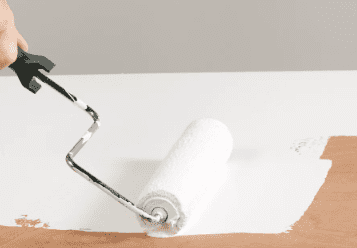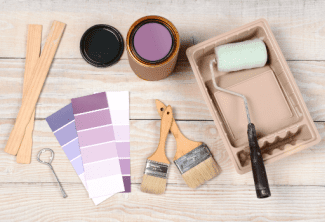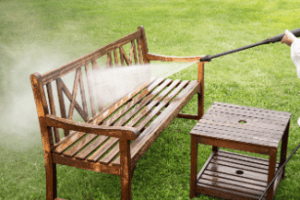Yes, You Can Paint Countertops—Here’s What to Know Before You DIY
Here’s what you need to know before reaching for a can of paint.

While painted countertops are definitely a viable option when planning an upgrade, there are a few things you need to know before you get started. “The pro of painting your countertops is that you are solely responsible for the look of the finished product,” says Andre Kazimierski of Improovy Painters. This can make for a fun DIY project that’s totally customizable based on your style and color preferences. But an amateur job can be an eyesore and cost more money to fix in the long run.
So while you can paint your kitchen or bathroom countertops, you might not always want to. Here’s everything you need to know before deciding to take on this DIY project.
Benefits of Painting Countertops
For laminate or tile countertops, paint offers an inexpensive facelift for a functional but dated countertop. It’s a fairly beginner-friendly DIY project, and you don’t need any fancy power tools to do it. And since there are so many paint colors available, you have more options than if you were to pick out a brand-new countertop material.
This is also one of the most inexpensive ways to transform your kitchen or bathroom. While you will need to invest in quality primer, paint, and sealer, you can complete this project for a fraction of the price of new countertops. There are many countertop paint kits available that are surface-specific and already include all the supplies you need, and there are even kits that can help you make a laminate or granite countertop look like marble.
Reasons Not to Paint a Countertop
Before you head to the hardware store to pick out your paint, there are a few factors to consider. Not every countertop can be painted (some stone materials are hard to paint) so consult with the experts at your local paint store before getting started. Keep in mind that this is a time-consuming project that will force you to stop using the kitchen or bathroom until the paint and top coat are completely dry.
A professional will likely be able to do this project faster, but hiring it out will raise the cost of the project. If you’re not confident in your DIY abilities, price out the cost of a professional versus the price of replacing the countertops with granite or laminate before you commit.
How to Paint Countertops
What You’ll Need

- Drop cloth
- Kitchen cleaner or degreaser
- Sanding block or sander
- Cloth or rag
- Primer
- Paint roller
- Paint tray
- Paint or countertop paint kit
Step 1: Decide If It’s Worth the Risk
If you like your existing countertops enough to live with them, you might want to pause before grabbing a can of paint. Removing paint from a countertop is nearly impossible, so decide if it’s really the countertop that’s bothering you or if there’s something else that’s an easier fix. Replacing lights, repainting cabinets, and painting walls can make the same old countertop feel brand new. Although tile, laminate, and granite countertops can all be painted, first decide if you want to risk ruining your existing surface if the project doesn’t turn out how you’d planned.
Step 2: Choose the Right Paint
When you’re ready to paint your countertops, get a paint kit that’s made for your surface or choose a paint that’s suited for the material of your countertop. Water-based acrylic paints work well for laminate counters. Epoxy coatings adhere well to tile and granite countertops after the surface has been cleaned, abraded, and primed. When in doubt, check the packaging on the paint before you buy it, and don’t forget to pick up protective gear, including eyewear and a mask, while you’re at the paint store.
Step 3: Prepare the Surface
No matter the countertop surface, you’ll want to prep it so the paint sticks better. Kazimierski recommends thoroughly cleaning the countertop (beyond just soap and water) before applying any kind of primer. It’s important to degrease the countertops, especially those near the stove or sink. Remove built-up grime, dirt, and oil before painting. Use a kitchen cleaner or detergent to clean the countertop, but avoid ammonia-rich cleansers for laminate or granite.
To improve the results with a laminate counter, be sure to repair any damage, then sand the surface to prepare it for a smooth finish. To improve results with granite, etch the stone before applying paint. Clean off any dust or excess. Make sure the surface is dry before applying primer.
Paying Too Much For Insurance?
Get a FREE quote to insure your rental properties for less.
Step 4: Coat the Surface with Primer
Before painting, use a paint roller to evenly apply a coat of primer to your countertops. Read the manufacturers’ labels to best apply primer. This white base bonding color ensures that any underlying colors stay hidden behind your new, fresh coat of paint. Let it dry overnight and ensure proper ventilation.
Step 5: Apply Paint
Use a roller to apply two generous layers of paint to the countertop. Be sure to apply thicker paints (like epoxy) evenly, so that there are no lumps or bubbles on the finished surface. Wait for the first coat to dry fully before adding a second, and make sure you read the instructions on the paint container to allow for proper drying time between coats. Let the second coat dry thoroughly and wait a few days before sealing with a top coat.
Step 6: Seal with a Top Coat or Resin
Once the paint is dry, you’ll need to protect the surface with a top coat or glossy resin. You’ll want to do two coats to ensure the longevity of the countertop, but the kind of top coat will depend on the original surface. The total cure time for most countertop paint jobs is around 14 days, so be careful about using your space before then.
Source: Better Homes & Gardens















 Accessibility
Accessibility